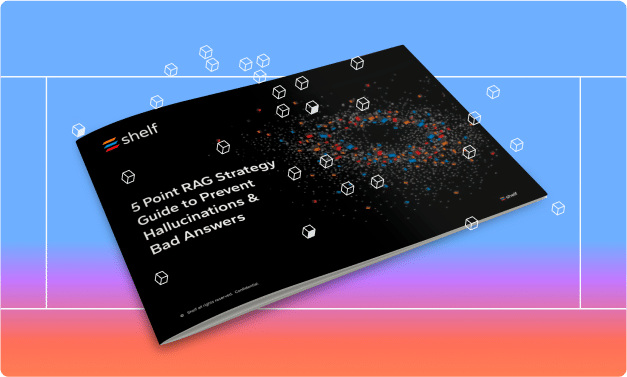In fact, according to recent industry analyses, one of the greatest challenges in deploying generative AI technologies involves managing the quality of data these models rely on. This issue is particularly true for organizations that use RAG systems to produce outputs from internal knowledge sources.
In previous articles of the series, we discussed some ways to improve your data quality: enriching your data, identifying data risks, and filtering out bad data. In this article, we’ll discuss the next key strategy: fixing your content at the source.
Your knowledge source is one of your most valuable assets. It’s the repository your LLMs use to generate accurate and meaningful responses. By refining the data at its origin, you can significantly improve the quality of the responses generated by your RAG models.
Let’s walk through four key processes designed to enhance the accuracy and reliability of your data: documenting content issues, analyzing necessary content changes, creating detailed tickets for content fixes, and implementing triggered partial content synchronization.
1. Document Content Issues Resulting in Poor Answers
RAG, which enhances language understanding and response generation in AI by pulling information from external sources, can sometimes produce poor or inaccurate answers. This can largely be traced back to issues with the source data used by these models.
Your first job, therefore, is to identify, document, and trace these discrepancies to improve the overall quality of data fed into RAG systems.
The first step in enhancing the quality of RAG outputs is identifying instances where the answers are subpar. This can manifest as responses that are factually incorrect, irrelevant, overly generic, or even inconsistent with established knowledge.
IT professionals and data scientists should use automated monitoring tools to flag outputs that deviate from expected results or that fail to meet certain quality thresholds.
Once a poor answer is identified, the next step is to trace and document the underlying content issues in the source material. This involves analyzing the data sources that the RAG system queried to generate its response.
Common issues include outdated information, factual inaccuracies, biased data, or content that lacks sufficient detail. It is crucial to document these findings clearly and systematically to aid in rectifying the source material or refining the retrieval processes.
Metrics to Evaluate Answer Quality
Evaluating the quality of an answer from a RAG system can be quantified using various metrics. One such metric is the Groundness Score, which assesses how well the answer is grounded in the source material provided to the model. A high Groundness Score indicates that the response is well-supported by the data, whereas a low score may suggest that the answer is speculative or poorly supported.
Other metrics might include accuracy, relevance, and coherence scores, which collectively help determine the reliability and usability of the answers generated. These metrics can be automated within the system, providing continuous feedback on performance and highlighting areas where improvements are necessary.
Leveraging Human Feedback
In addition to automated metrics, human feedback plays a critical role in evaluating and improving the outputs of RAG systems. Subject matter experts and end-users can provide insights that are not easily captured by automated systems.
For example, they can judge the practical utility of answers, detect nuances, and assess the tone or formality of the content. This feedback should be systematically collected and analyzed to inform adjustments in both the RAG’s configuration and its source data.
By addressing these content issues at the source, organizations can significantly enhance the performance of their RAG solutions, leading to more accurate, reliable, and useful AI-generated content.
2. Analyze What Content Changes are Necessary to Improve Poor Answers
After identifying and documenting instances where a RAG system delivers subpar answers due to issues in the source content, the next step is to determine the necessary changes to improve the quality of the data.
This process involves a detailed evaluation of the proposed changes to determine their potential impact on the RAG system’s accuracy and reliability.
Assessing the Accuracy and Relevance of Existing Content
Before making any changes, a thorough assessment of the existing content is necessary. This involves checking for factual accuracy, timeliness, and relevance to the queried topics. Evaluate whether the content aligns with the latest verified information and whether it addresses the topics that users are querying about. This assessment helps in pinpointing specific areas where updates and corrections are needed.
Identifying Gaps in Coverage
Analyze the completeness of the content. Are there topics or subtopics that are frequently queried but poorly covered? Identifying gaps in content coverage is crucial as these are direct contributors to poor answers. By mapping out these gaps, you can prioritize areas for enhancement or inclusion in the content pool.
Evaluating Source Reliability
The reliability of the sources from which the content is drawn must be evaluated. Are the sources authoritative and trusted within their respective fields? The credibility of the underlying sources directly impacts the trustworthiness of the RAG system’s responses. This step involves a review of the source materials’ origin, authorship, and any potential biases they may contain.
Testing Changes with Simulated Queries
Proposed changes can be initially tested through simulated queries. This method involves running controlled queries through the RAG system to observe how modifications in the content affect the answers generated. Simulated queries can provide concrete examples of how new or revised content would perform under real-world conditions, offering insights into the potential benefits or drawbacks of these changes.
Soliciting User and Expert Feedback
Gathering feedback from subject matter experts and real users can provide an additional layer of scrutiny. Experts and users can assess the validity of proposed changes and their potential impact on the field. This step is crucial for technical or specialized content where depth of knowledge is essential.
By carefully analyzing proposed content changes through these methods, you can strategically plan which modifications will substantially enhance the accuracy and reliability of your RAG solution. This preparatory work ensures that any subsequent changes are both effective and aligned with the goal of delivering high-quality, reliable answers.

3. Create Tickets for Required Content Fixes
After the necessary content changes have been identified and analyzed, the next step is to systematically create detailed tickets for the content owners or responsible teams. This process ensures that the proposed changes are efficiently communicated and managed.
Each ticket should include several key elements to ensure it is both informative and actionable:
- Summary of the Issue: Provide a concise description of the content issue. This might include inaccuracies, outdated information, gaps in content, or instances of bias that need addressing.
- Detailed Description: Elaborate on the specific problems identified during the analysis phase. Include examples or references to specific sections of content that require updates. This helps content owners understand the context and the specific nature of the issue.
- Proposed Changes: Clearly outline the suggested content updates or additions. If applicable, provide revised text or supplementary information that should be included to resolve the issue.
- Expected Impact: Discuss the potential benefits of making these changes, specifically how they will improve the accuracy, reliability, and overall performance of the RAG system. Highlight the expected improvements in answer quality that will result.
- Priority and Deadlines: Assign a priority level to the ticket based on the severity of the issue and its impact on the RAG system’s performance. Include a reasonable deadline for when the changes should be reviewed and implemented, encouraging timely action.
- Responsible Party: Assign the ticket to the appropriate content owner or team. Ensure that the individual or team has the expertise and access necessary to make the required updates.
Effective Communication Through Tickets
It is crucial that these tickets are crafted with enough detail to enable content owners to fully understand the significance of the changes and how they contribute to the overall system’s efficacy. Since data scientists might not own or directly manage the content, the tickets should bridge any knowledge gaps and provide a clear pathway for the necessary updates.
Additionally, maintaining an open channel of communication is essential for addressing any questions or clarifications the content owners might have. This helps in ensuring that the changes are implemented accurately and efficiently.

4. Implement Triggered Partial Content Sync
To maintain the accuracy and relevance of the RAG system, it’s essential to implement a mechanism for triggered partial content synchronization. This process ensures that updates made to the content (based on your tickets) are quickly reflected in the system, without the need for reprocessing the entire knowledge base. Here’s how this process works:
Triggered Partial Content Sync
Triggered partial content synchronization involves updating the RAG system’s content repository in real-time or near-real-time as individual documents or data segments are updated. It’s used to ensure that only specific, updated sections of a dataset are synchronized with a larger database or knowledge base, rather than reprocessing the entire data set.
When a change is made to a part of the data — such as updating the price of a product in a database — an automatic update that synchronizes only the affected data is triggered.
This targeted update process is efficient because it avoids the time and resource consumption associated with re-indexing the entire database. The trigger ensures that the system immediately reflects the most current and accurate information, enhancing the system’s overall responsiveness and reliability without the overhead of a full-scale synchronization.
This approach is particularly valuable in environments where data updates are frequent and where accuracy and timeliness of information are critical, such as in dynamic pricing, content management systems, or any live data-driven application or service.
Triggered Partial Content Sync Benefits
This method of partial content synchronization offers several advantages:
- Efficiency: It avoids the overhead of full database re-indexing, making the update process faster and less resource-intensive.
- Accuracy: By ensuring that updates are reflected swiftly, the RAG system can provide outputs that are accurate and up to date, enhancing user trust and system reliability.
- Scalability: This approach is scalable as it allows for individual updates without overwhelming the system with frequent large-scale re-indexing tasks.
Implementing triggered partial content sync is crucial for maintaining the operational efficiency and accuracy of RAG systems. By focusing on targeted updates, this mechanism ensures that the RAG solution operates with the most current and relevant information, thereby significantly improving the quality of its outputs.
Triggered Partial Content Sync Process
Let’s walk through the step-by-step process of how a triggered partial content sync works.
Once you have identified and documented the data issues, analyzed and proposed changes, and created a ticket for the content owner, a trigger mechanism is activated to sync these changes with the RAG system. This mechanism is configured to detect changes in the source content and initiate a partial sync to update only the affected parts of the content repository.
The specific document containing the updated product price is then reprocessed and re-indexed in the RAG system. This targeted approach ensures that only the relevant document is updated, rather than the entire database.

Better Data Source, Better Output
Addressing content issues at their source is crucial for optimizing the performance of RAG systems. By systematically documenting, analyzing, and correcting data inaccuracies, organizations can significantly enhance the reliability and accuracy of their AI systems. Implementing triggered partial content syncs ensures that these improvements are reflected swiftly, maintaining the currency and relevance of the data.
Ultimately, these steps are vital in building more robust and effective AI-driven solutions that can trustworthily interact with and generate knowledge.




